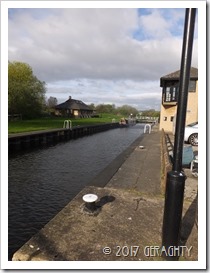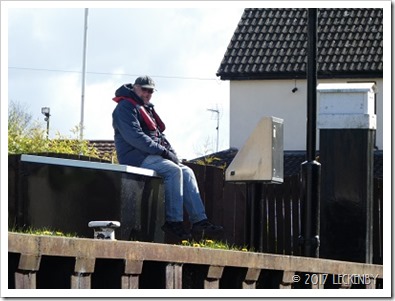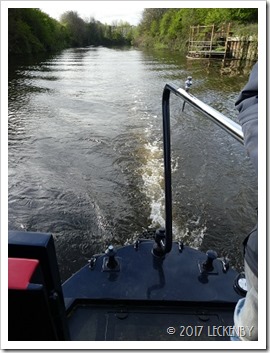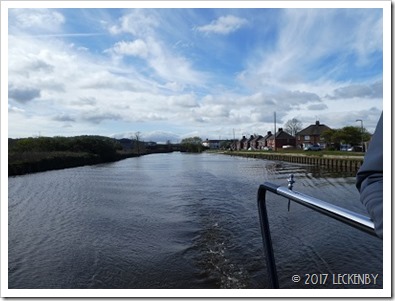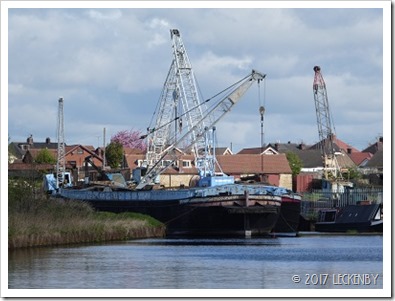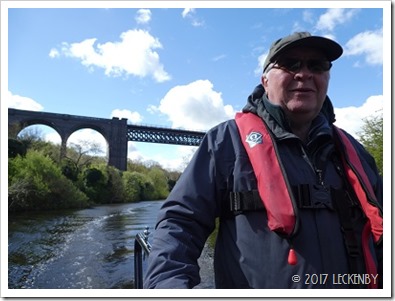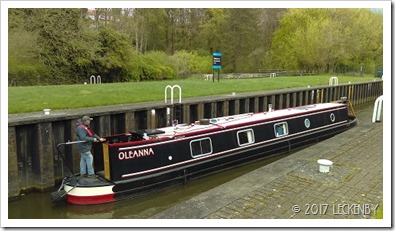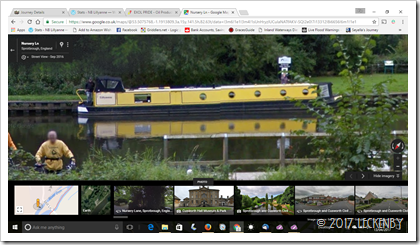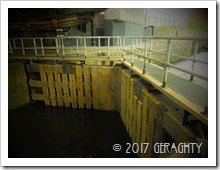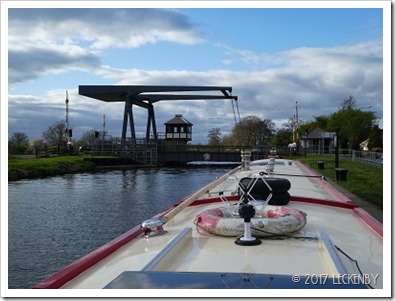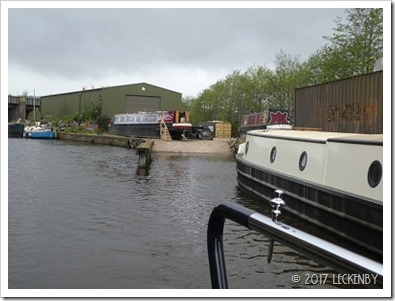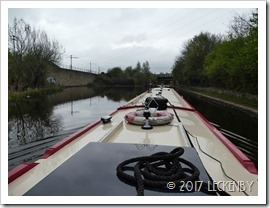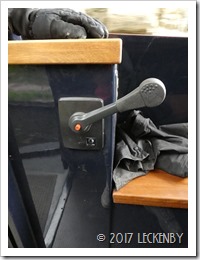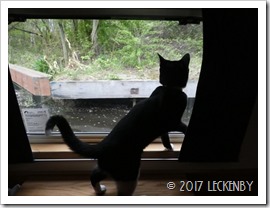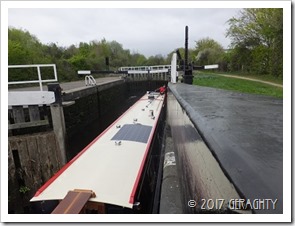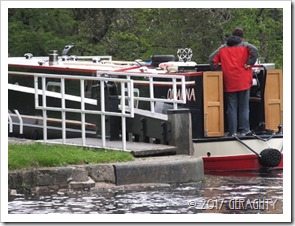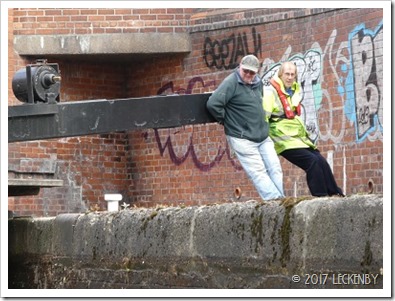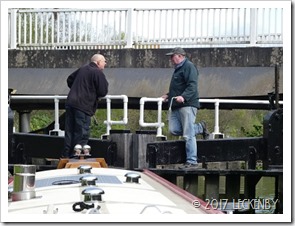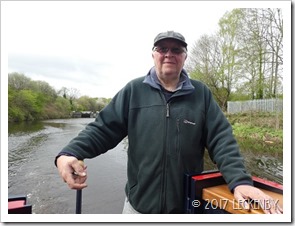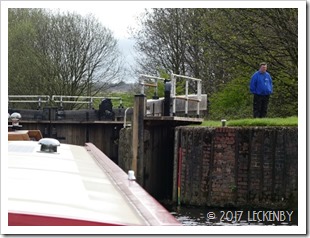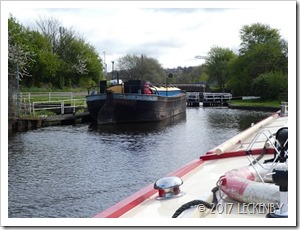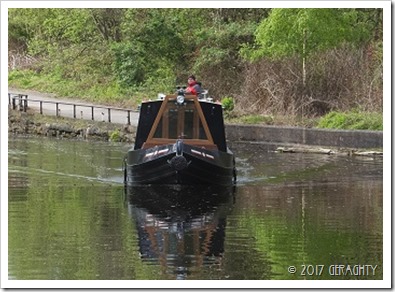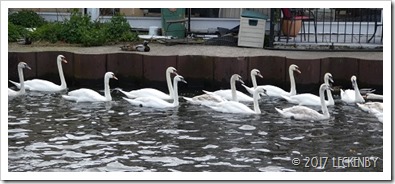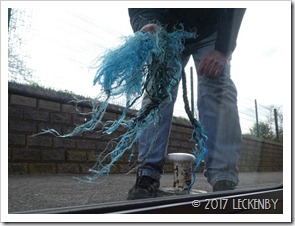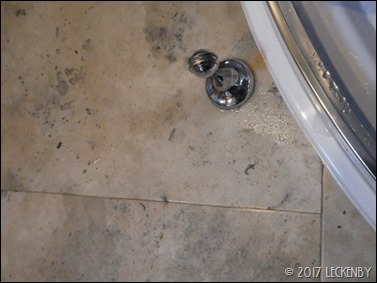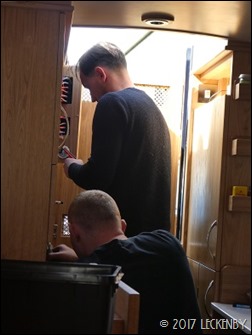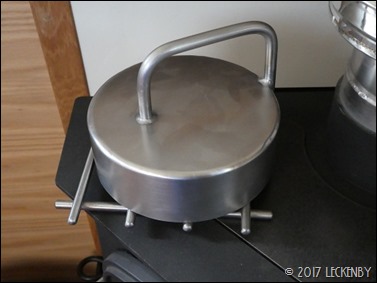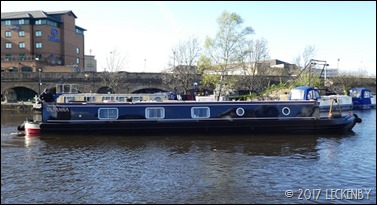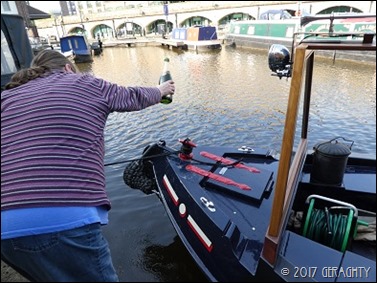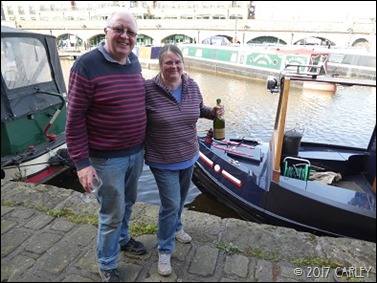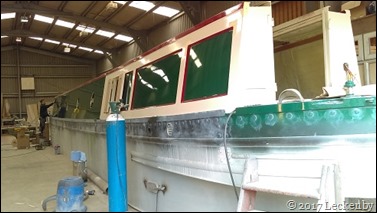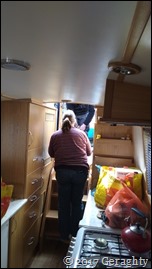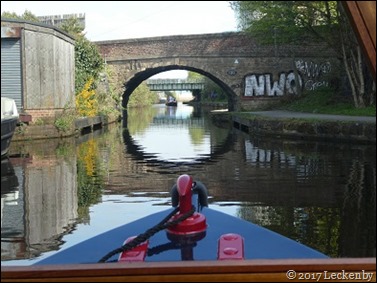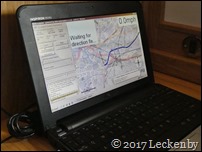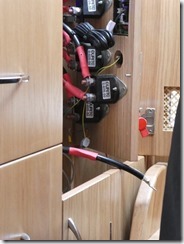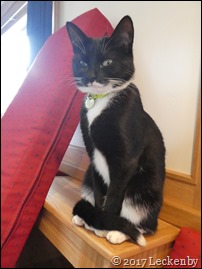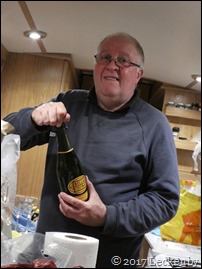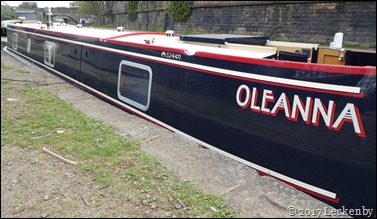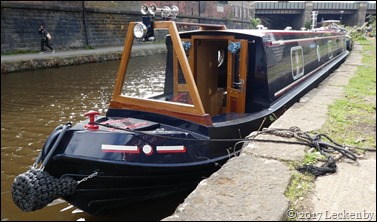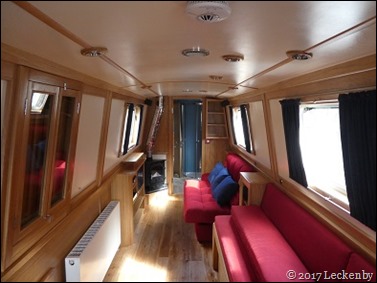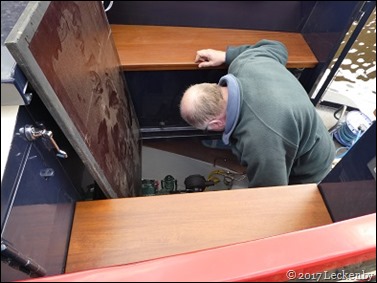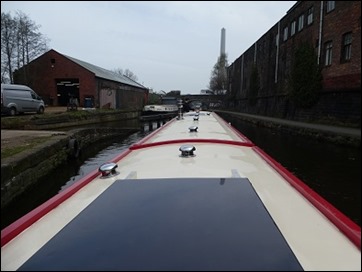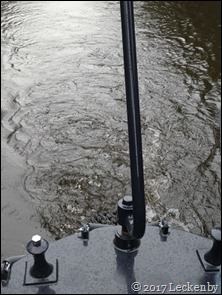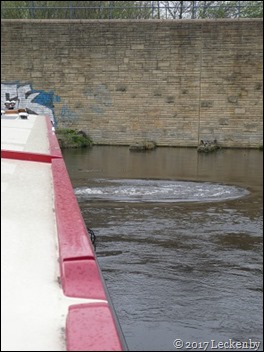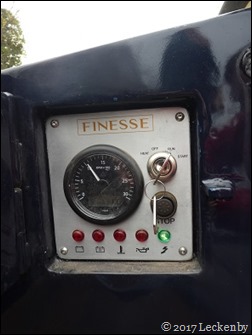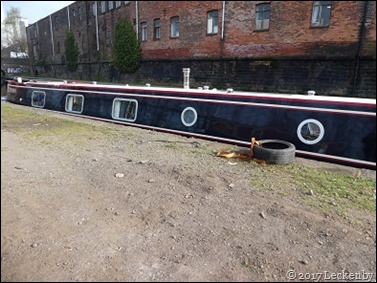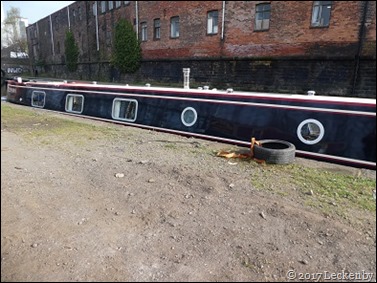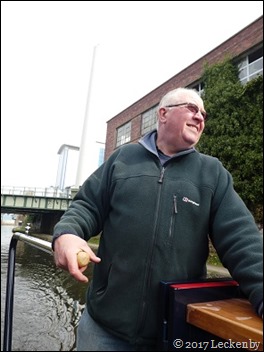Bramwith Junction to Keadby Lock
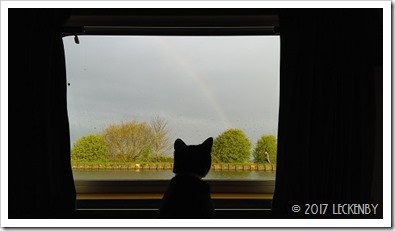 Waking in the morning to a view is great. Todays view did however mean that we would be seeing some rain during the day. We did allow ourselves a bit of a lull in bed before a quick breakfast and pushing off at 8.45am.
Waking in the morning to a view is great. Todays view did however mean that we would be seeing some rain during the day. We did allow ourselves a bit of a lull in bed before a quick breakfast and pushing off at 8.45am.
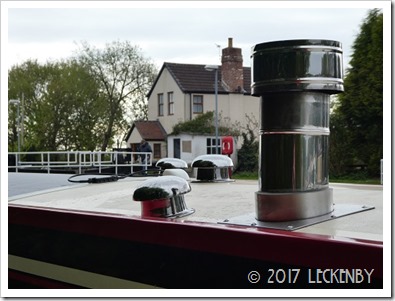 Not far to our first lock, back onto short wide locks. Mick went ahead to fill the lock and just as I was untying Oleanna a huge widebeam pulled out and started to reverse towards the water point opposite me. A couple of minutes and I’d have been out of his way and in the lock, but instead I did my best to cling onto Oleanna (which is harder than normal at the moment) whilst he toed and froed back and forth. As soon as I thought there was enough space for me to pull out I did. Gosh the lock was short, yesterday I could motor in and have plenty of time to stop, today I gingerly edged Oleanna forward to be clear of the cil.
Not far to our first lock, back onto short wide locks. Mick went ahead to fill the lock and just as I was untying Oleanna a huge widebeam pulled out and started to reverse towards the water point opposite me. A couple of minutes and I’d have been out of his way and in the lock, but instead I did my best to cling onto Oleanna (which is harder than normal at the moment) whilst he toed and froed back and forth. As soon as I thought there was enough space for me to pull out I did. Gosh the lock was short, yesterday I could motor in and have plenty of time to stop, today I gingerly edged Oleanna forward to be clear of the cil.
The first of todays many bridges was just up ahead where there was a boat waiting to come through. So we obliged by pressing the buttons for them so they didn’t have to come out of their wheel house in the rain, we were starting to get wet anyway. On we pootled through the wooded section where the towpath looks like it has had the pot holes filled to improve the ride for the local motorbikes.
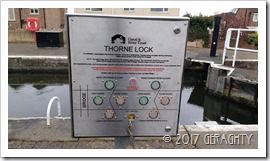
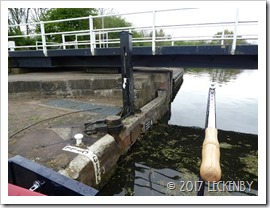 Much sooner than we thought we were approaching Thorne. Yesterday I’d called ahead to check on diesel prices, Staniland 75p Thorne Boating Services 72p, so we continued on past Staniland to the lock. Here there is a swing bridge just before the lock and the two are interlinked, so you have to fill the lock and open the gates (all button operated) before you can swing the bridge. Since we were last here some alterations have been made to the controls. No longer is there a hole dissertation on the side of the control panel for you to fathom your way through, it is much easier.
Much sooner than we thought we were approaching Thorne. Yesterday I’d called ahead to check on diesel prices, Staniland 75p Thorne Boating Services 72p, so we continued on past Staniland to the lock. Here there is a swing bridge just before the lock and the two are interlinked, so you have to fill the lock and open the gates (all button operated) before you can swing the bridge. Since we were last here some alterations have been made to the controls. No longer is there a hole dissertation on the side of the control panel for you to fathom your way through, it is much easier.
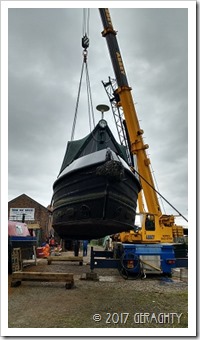
 A crane came into view at Thorne Boating Services, they were preparing to lift a boat out so we reversed into one of the service moorings to wait. When we were given the all clear Mick brought us round, only to be told that the hose wouldn’t reach. So back we went to the services to wind, which of course meant that we had to wind again after we’d finished.
A crane came into view at Thorne Boating Services, they were preparing to lift a boat out so we reversed into one of the service moorings to wait. When we were given the all clear Mick brought us round, only to be told that the hose wouldn’t reach. So back we went to the services to wind, which of course meant that we had to wind again after we’d finished.
The diesel tank was filled to the top for the first time in it’s life. Ricky had said that this would calibrate the gauge, however it still doesn’t read full. With gas heating we are not sure how long a 13kg bottle will last. On Lillian we change a bottle every three months, but that was only used for cooking. So we decided to pay the deposit on a second bottle of gas. If we come across an empty bottle or two somewhere we’ll pick them up and trade them back in for the deposit. Two new float keyrings and some weed hatch tape for our fender hooks were our other purchases, shame we forgot to get a bag of coal!
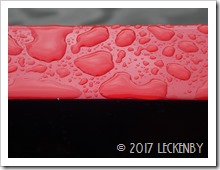 Due to waiting for the flying boats we were a bit behind and canalplan had suggested it would take us nearly four hours to reach Keadby, so no time to stop for lunch as we were meeting friends. The two times we’ve done this stretch I’ve had problems with Thorne Bridge, the barriers have been a bit temperamental and so were the lights on the panel. Mick went armed with this information and I expected to have to wait for a while. When he turned the key there was a ticking from the barriers, this stopped when all were shut, a new feature! Someone has at last solved the problems on this bridge, they were most probably getting bored of the phone calls.
Due to waiting for the flying boats we were a bit behind and canalplan had suggested it would take us nearly four hours to reach Keadby, so no time to stop for lunch as we were meeting friends. The two times we’ve done this stretch I’ve had problems with Thorne Bridge, the barriers have been a bit temperamental and so were the lights on the panel. Mick went armed with this information and I expected to have to wait for a while. When he turned the key there was a ticking from the barriers, this stopped when all were shut, a new feature! Someone has at last solved the problems on this bridge, they were most probably getting bored of the phone calls.
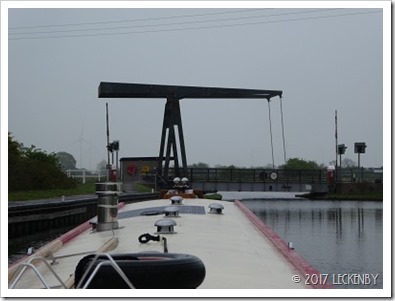 Then we worked our way through more bridges, one lift the others swing, each one a bit different to the others. Our waterproofs earnt their keep as the heavens kept opening. The railway hugs onto the side of the cut for most of the way and the skyline is filled with wind turbines. With the deep grey clouds and the bright yellow rape seed the view was still a jolly even if wet.
Then we worked our way through more bridges, one lift the others swing, each one a bit different to the others. Our waterproofs earnt their keep as the heavens kept opening. The railway hugs onto the side of the cut for most of the way and the skyline is filled with wind turbines. With the deep grey clouds and the bright yellow rape seed the view was still a jolly even if wet.
 As we approached the last of the swing bridges we could see another boat ahead, would they wait for us? No we were quite a distance behind. Just after the swing bridge is Vazon Sliding Rail Bridge which is operated from the signal box. As I was just bringing Oleanna through the swing bridge and Mick was starting to close it I could hear the sirens going that indicate that the sliding bridge was about to open. Before we’ve had to wait five ten minutes, but today as Mick stepped on the stern the bridge started to slide to open up the cut for us.
As we approached the last of the swing bridges we could see another boat ahead, would they wait for us? No we were quite a distance behind. Just after the swing bridge is Vazon Sliding Rail Bridge which is operated from the signal box. As I was just bringing Oleanna through the swing bridge and Mick was starting to close it I could hear the sirens going that indicate that the sliding bridge was about to open. Before we’ve had to wait five ten minutes, but today as Mick stepped on the stern the bridge started to slide to open up the cut for us.
Just as we were finishing tying up at the moorings two familiar faces were walking towards us. Bridget and Storm from NB Blackbird had come to meet NB Oleanna. Many things were inspected and we may have helped them find some good door furniture for their new house. A cuppa and catching up was done along with some toilet talk, I forgot to ask how their grandsons first birthday party was last weekend. We also reaffirmed plans of doing the Ribble link together later this year. Thank you very much for the presents Bridget.
 Oleanna had reached 25 engine hours today, the gear box oil needed changing. So Mick got into the engine bay and gave her a freshen up. Several other boats have turned up ready to go down the lock tomorrow. We will be one of three going to Torksey or beyond if we are making good time. The anchor has been attached, so all we need now is a good nights sleep if the visitors to the car park allow.
Oleanna had reached 25 engine hours today, the gear box oil needed changing. So Mick got into the engine bay and gave her a freshen up. Several other boats have turned up ready to go down the lock tomorrow. We will be one of three going to Torksey or beyond if we are making good time. The anchor has been attached, so all we need now is a good nights sleep if the visitors to the car park allow.
 2 locks, 15.06 miles, 1 lift bridge, 8 swing bridges, 1 sliding bridge, 13 held up plus 2 dogs, 2 wet boaters, 80 litres diesel, 2 key floats, 1m tape, £40 deposit, 1 low flying boat, 1 wire twist extension, 9 trains, 2 visitors, 4 bean plants, 2.5 litres oil, 1 anchor, 1 boat ready, 1 Mark out of 3, 2 grins, 3 motorbikes already.
2 locks, 15.06 miles, 1 lift bridge, 8 swing bridges, 1 sliding bridge, 13 held up plus 2 dogs, 2 wet boaters, 80 litres diesel, 2 key floats, 1m tape, £40 deposit, 1 low flying boat, 1 wire twist extension, 9 trains, 2 visitors, 4 bean plants, 2.5 litres oil, 1 anchor, 1 boat ready, 1 Mark out of 3, 2 grins, 3 motorbikes already.
This is a dual post with NB Lillyanne’s Blog.
Our blogs will be changing, as we now have built our boat and NB Lillyanne will be up for sale in a few weeks. We’ll let you know what is happening once we know.


